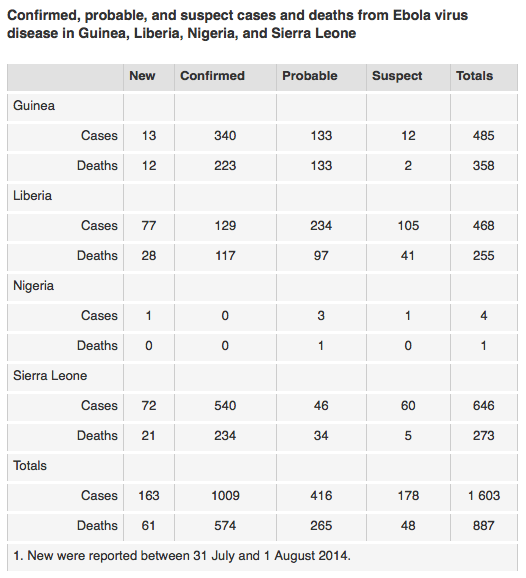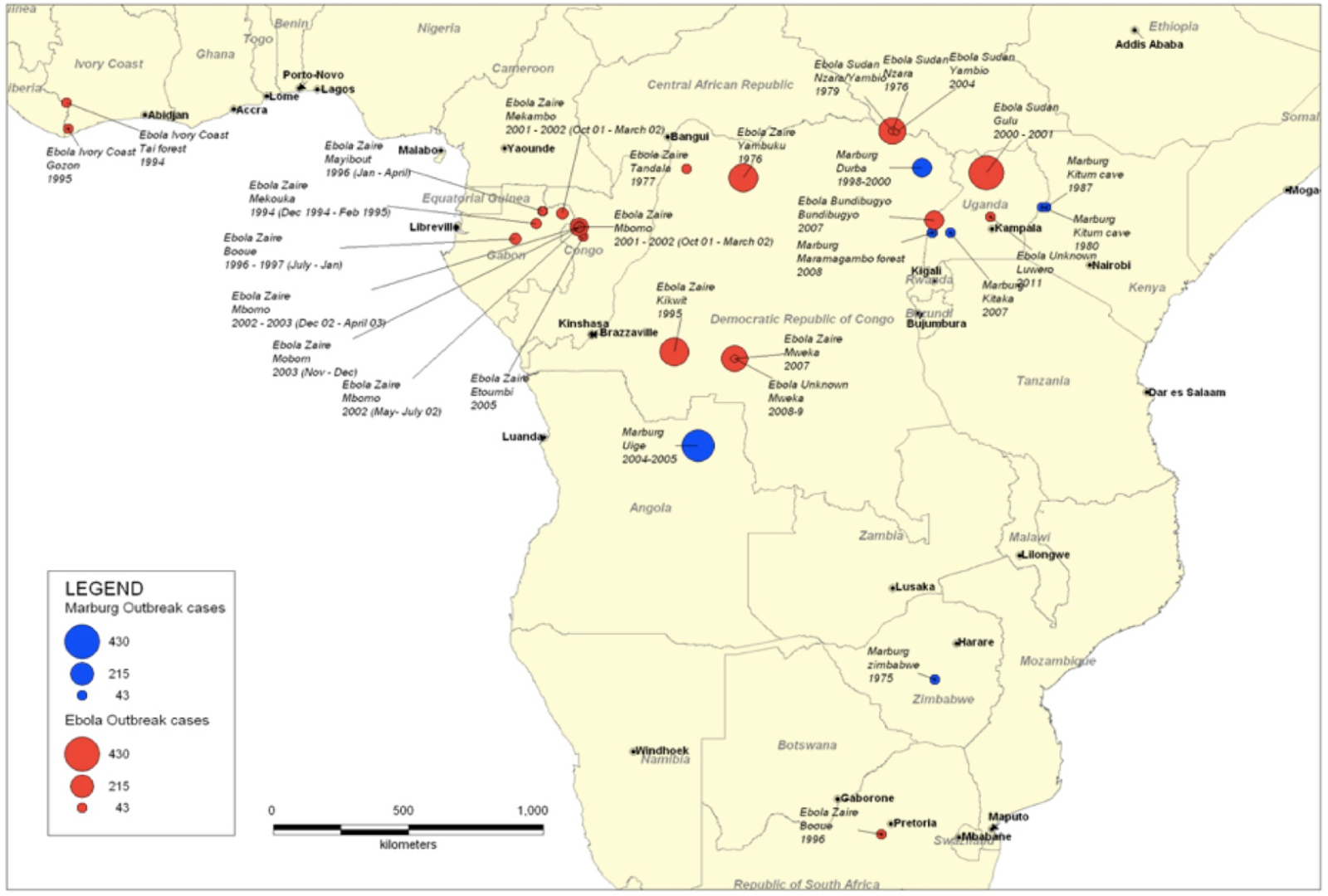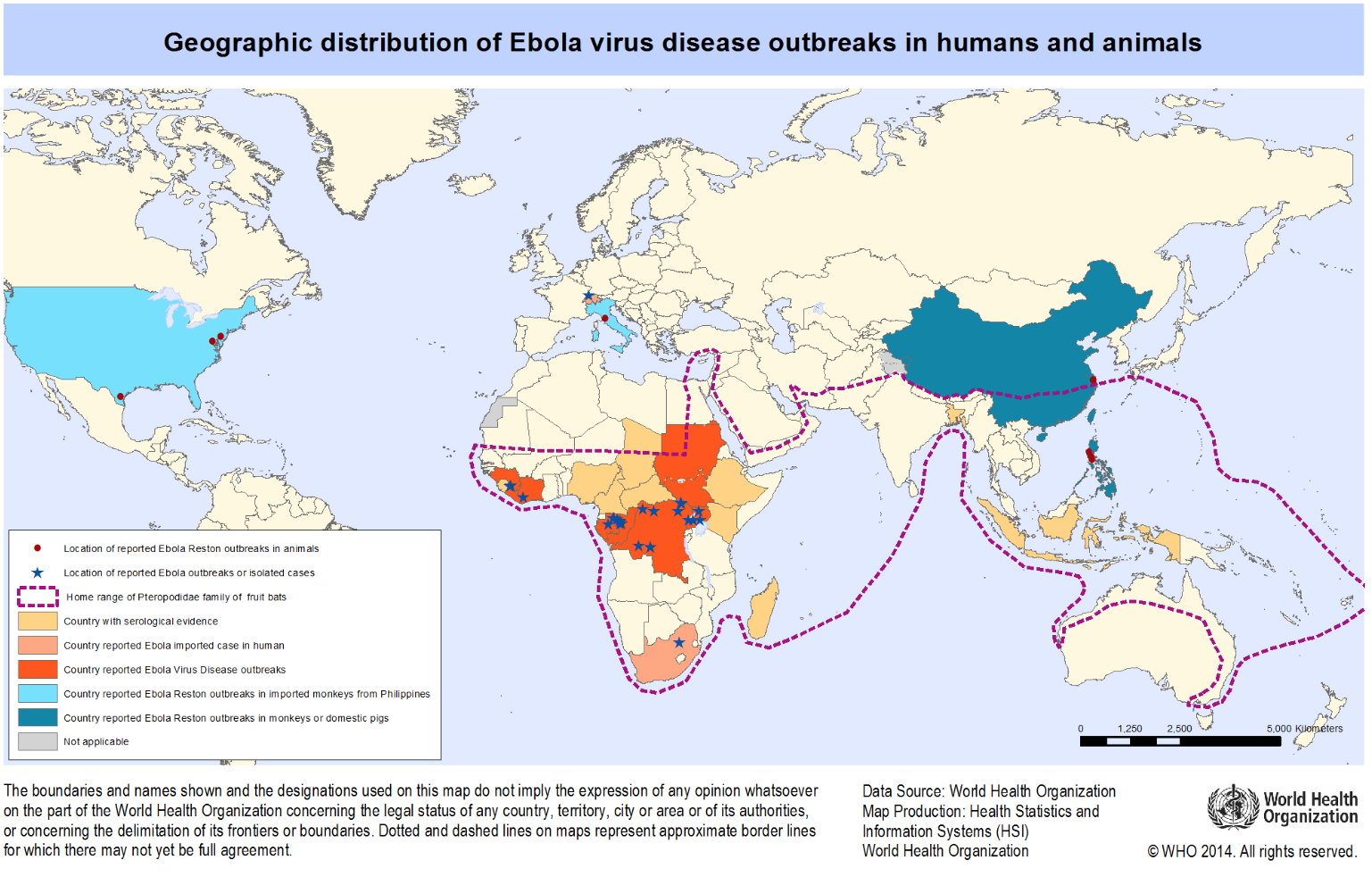With Ebola back in the world's news cycle, I wanted to take this opportunity to gather data on the disease from several sources to provide us with a comprehensive yet easy to understand primer.
Let's open with this chart showing the statistics from the most recent outbreak in Guinea, Liberia, Nigeria and Sierra Leone:
Ebola first appeared in 1976 in two simultaneous outbreaks in the rain forests of central and western Africa, specifically in the Sudan and in the Democratic Republic of the Congo. The disease is named for the Ebola River, which is located close to the village of Yambuku, DRC. The first outbreak of Sudan ebolavirus infected over 284 people with a mortality rate of 53 percent. The second outbreak of Zaire ebolavirus infected 318 people and had a mortality rate of 88 percent.
Ebola virus disease (EVD) was formerly known as Ebola Haemorrhagic Fever (Ebola HF), is transmitted to people from species of wild animals, particularly fruit bats of the speices Hypsignathus monstrous and Epomops franqueti. It is believed that African pig farms amplify the infection because of the presence of fruit bats on these farms. Once a human is infected, the virus can be transmitted from human to human through contact with the bodily fluids of those already infected or from objects that have been contaminated by contact with an infected person. Since sufferers bleed both internally and externally, without proper biohazard precautions, the disease is easily spread in the less technologically advanced hospitals and clinics of the developing world.
Ebola is caused by infection with a filovirus and has five subspecies, four of which have caused the disease in humans:
1.) Ebola virus or Zaire ebolavirus.
2.) Sudan virus or Sudan ebolavirus.
3.) Tai Forest virus or Tai Forest ebolavirus.
4.) Bundibugyo virus or Bundibugyo ebolavirus.
5.) Reston virus or Reston ebolavirus.
The last subspecies which I posted about here, does not appear to cause the disease in humans although humans can test positive for antibodies. It is this subspecies of Ebola that caused an outbreak among test primates in the United States in 1996.
Symptoms of Ebola appear between 2 and 21 days after exposure with most cases appearing between 8 and 10 days after exposure. The initial symptoms of Ebola include a high fever, joint and muscular pain, weakness, dizziness, headache and sore throat. Many of these symptoms are similar to those found in malaria and cholera, two relatively common diseases in Africa. This makes it difficult to diagnose Ebola unless samples are sent to a laboratory that has the ability to do advanced analyses of samples provided by caregivers. As the disease progresses, the body may bleed through its orifices, including the eyes, ears, nose, mouth and rectum. Internal bleeding is also common. Vomiting, diarrhea and breathing difficulties are also common. A painful rash may appear over the body with blood-filled blisters. Laboratory tests will show that white blood cell and platelet counts are low and liver enzymes are elevated. Infected persons will remain infectious as long as their blood and secretions contain the virus; 61 days after the onset of symptoms, viable Ebola virus was obtained from the semen of a patient. Obviously, all of this means that any samples taken from patients should be considered an extreme biohazard risk.
Contracting Ebola is very serious since it has a very high mortality rate. Among the cases in humans, since 1976, the mortality rate is between 41 percent and 89 percent. In the case of the Bundibugyo subspecies, since it was first discovered in late 2007 in Uganda, the mortality rate among those infected has varied from 25 percent to 36.1 percent.
From the Centers for Disease Control and Prevention, here is a listing of all Ebola outbreaks since 1976:
Here is a map showing the history of Ebola outbreaks in central and western Africa:
Here is a map from WHO showing the countries with evidence of Ebola virus in both humans and animal populations:
Treatment of Ebola is limited to supportive care since there is no cure at this time. Patients must be kept hydrated using intravenous fluids and given oxygen to assist with breathing. As well, medications can be given to control fever, maintain blood pressure and prevent secondary infections. WHO recommends that all caregivers that are within 1 metre of patients should wear protective face shields or a medical mask and goggles, gloves and a clean long-sleeved gown. At the current time, no drug has been approved to treat Ebola, however, research for a vaccine is being undertaken. An experimental drug, ZMapp has been used in the recent cases in the United States to boost the immune systems of the infected, however, the drug has still not been approved for use in humans.
Ebola is particularly dangerous to Africa. Many of its rural hospitals are understaffed and under-equipped with protective equipment when it comes to dealing with a local epidemic of a deadly virus. As well, with the virus now entering Guinea's densely populated capital city of Conakry, the virus could spread far faster and to many more individuals than it ever has before, given that most previous outbreaks were in rural areas.
References:
Click HERE to read more of Glen Asher's columns
You can publish this article on your website as long as you provide a link back to this page.





Be the first to comment